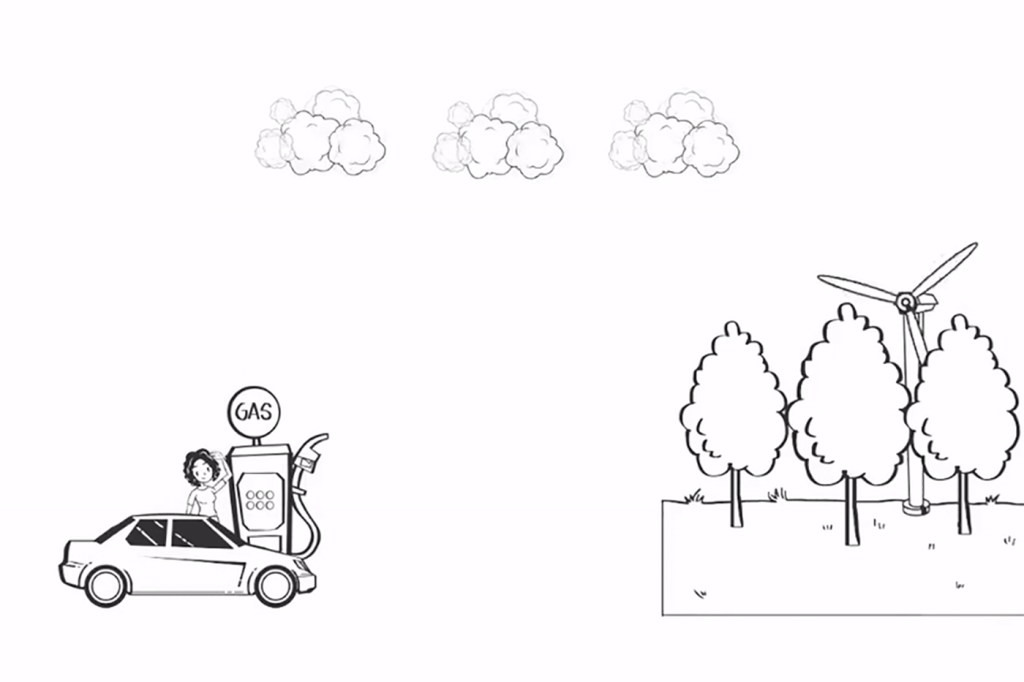Would you pay 10 cents extra for gas to save the planet?

The idea is deceptively simple—offset 100 percent of your car’s carbon emissions by volunteering to pay an extra 10 cents a gallon at the pump.
It may sound like a pipe dream, but Kyle Kornack believes that in an era of government inaction, there’s a hunger for this type of DIY social responsibility.
“With 40 million people fueling up at the pump each day, we envision gas stations as hubs of environmental advocacy,” said Kornack, who graduated from Northeastern in 2013 with a degree in environmental studies and philosophy.
We envision gas stations as hubs of environmental advocacy.
Kyle Kornack, Environmental Science ’13
He cites a 2017 AP poll that suggests 74 percent of the U.S. population believe climate change is important, with 53 percent saying it’s “very important.”
“People recycle their trash, change all their light bulbs, and use public transportation whenever they can—and yet when then they hop in their car, they have no choice but to use fossil fuels,” Kornack said. “It’s an outlier in their lives, and there’s lots of frustration.”
Kornack and his two partners—Liam Madden, who received a degree in international affairs in 2012, and David Cooch, a biology major who graduated in 2013—set out to ease this frustration by founding Green Gas, a company that makes it easy for drivers to erase their carbon footprint.
The company offers environmentally conscious motorists two options. In March, the partners launched a special debit card that automatically pays an extra 10 cents per gallon, which goes directly to several certified carbon offset programs. This summer they will launch as second option that allows drivers to push a button on the pump touch screen (the same screen that asks if you want a car wash today) to make a similar donation.
The touch screen option will be piloted this summer at 15 Sunoco stations around New England. Kornack said the pilot program will give the start-up an opportunity to prove its concept and hone its message.
“It’s a visceral experience because we’re asking them to donate at the moment they’re pumping gas, and smelling the fossil fuel,” said Kornack. “It’s the moment when they feel the strongest need to act.”
Green Gas has demonstrated the resonance of its message. In March 2017, Kornack made a presentation at the United Nations, and won a competition that resulted in the company being designated as a members of the MIT Solve Initiative.
“By embedding carbon offsets at point of purchase, we’re making the right thing to do, the easy thing to do,” he told the committee.
The company also won $10,000 in gap funding from Northeastern and a $130,000 fellowship from a yet-to-be announced source.
As for the 10-cent-per-gallon donation, only one penny goes to running the company, Kornack said. The remaining 90 percent goes directly to Certified Emission Reduction programs.
By embedding carbon offsets at point of purchase, we’re making the right thing to do, the easy thing to do.
Kyle Kornack, Environmental Studies ’13
For example, money from the gas station pilot program will go to GreenTrees, a reforestation program along the Mississippi River. Not only has the program planted 120,000 acres of trees so far, there are a host of other environmental benefits.
“Absorbing carbon is just the tip of the iceberg,” said Kornack. “This project is also restoring habitat needed by migratory waterfowl, creating a natural buffer zone to reduce pesticide runoff into the Mississippi River.”
Another project, Taking Root, is paying Nicaraguan farmers to reforest depleted land with coffee threes and other crops that will generate income while absorbing carbon emission.
Closer to home, Green Gas is contributing to a project in New Bedford, Massachusetts, that is converting methane emissions from the landfill into energy.
“Methane has 75 times the carbon emissions as fossil fuels,” said Kornack. “It’s a greenhouse gas on steroids.”
Kornack emphasizes that Green Gas doesn’t require large percentage a majority of Americans to participants in order to to make a substantial impact.
“If just 2 percent of the people participate, that’s 3,000 people per gas station per year,” he said. “There are 150,000 gas stations in the U.S.
“The people who are going participate in this initiative feel a responsibility to clean up after themselves—to reduced their carbon footprint. We’re making it easy for them to do it with the push of a button.”





